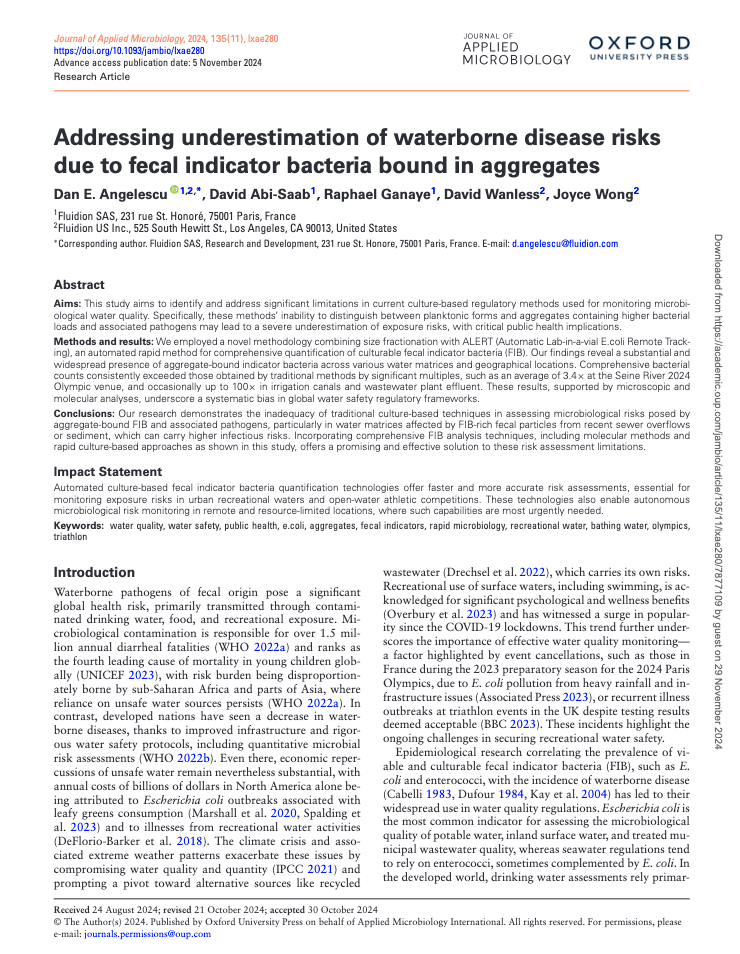
Addressing Underestimation of Waterborne Disease Risks Due to Fecal Indicator Bacteria Bound in Aggregates
Accepted for publication in the Journal of Applied Microbiology. Initially published on bioRxiv doi: https://doi.org/10.1101/2024.07.31.605961 (2024)

Journal of Applied Microbiology article: "Addressing Underestimation of Waterborne Disease Risks Due to Fecal Indicator Bacteria Bound in Aggregates"
This research manuscript was uploaded as a bioRxiv preprint on July 31st 2024, the day when the first Olympic aquatic event was held in the Seine river, due to the urgency and importance of its findings. In the meantime, the article underwent peer review, and is now publised in the Journal of Applied Microbiology and available online. A summary is also available in the following free article from The Microbiologist.
The research highlights significant limitations in traditional methods for detecting fecal indicator bacteria (FIB), such as E. coli, which fail to account for bacteria bound in aggregates, leading to substantially underestimated waterborne disease risks. ALERT technology, developed by Fluidion, is an automated rapid method for measuring both planktonic (free-floating) and comprehensive (including aggregate-bound bacteria) E.coli counts. In certain waters, the comprehensive measurement can provide much higher bacterial counts than traditional methods. The study underscores the need to update global water safety regulatory frameworks to include more accurate testing methods and automation, enhancing water quality monitoring and public health protection, and enabling monitoring in resource-limited or remote locations, which do not have access to laboratory services.
Aims
This study aims to identify and address significant limitations in current culture-based regulatory methods used for monitoring microbiological water quality. Specifically, these methods’ inability to distinguish between planktonic forms and aggregates containing higher bacterial loads and associated pathogens may lead to a severe underestimation of exposure risks, with critical public health implications.
Methods and Results
We employed a novel methodology combining size fractionation with ALERT, an automated rapid method for comprehensive quantification of culturable fecal indicator bacteria (FIB). Our findings reveal a substantial and widespread presence of aggregate-bound indicator bacteria across various water matrices and geographical locations. Comprehensive bacterial counts consistently exceeded those obtained by traditional methods by significant multiples, such as an average of 3.4× at the Seine River 2024 Olympic venue, and occasionally up to 100× in irrigation canals and wastewater plant effluent. These results, supported by microscopic and molecular analyses, underscore a systematic bias in global water safety regulatory frameworks.
Conclusions
Our research demonstrates the inadequacy of traditional culture-based techniques in assessing microbiological risks posed by aggregate-bound FIB and associated pathogens, particularly in water matrices affected by FIB-rich fecal particles from recent sewer overflows or sediment, which can carry higher infectious risks. Incorporating comprehensive FIB analysis techniques, including molecular methods and rapid culture-based approaches as shown in this study, offers a promising and effective solution to these risk assessment limitations.
Impact Statement
Automated culture-based FIB quantification technologies offer faster and more accurate risk assessments, essential for monitoring exposure risks in urban recreational waters and open-water athletic competitions. These technologies also enable autonomous microbiological risk monitoring in remote and resource-limited locations, where such capabilities are most urgently needed.
